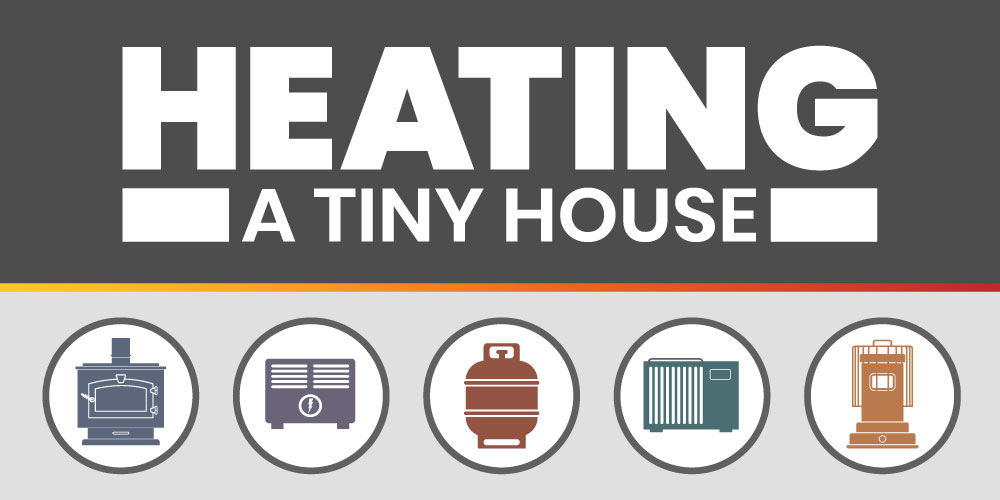
NAVIGATION
Heating a tiny house in the winter has it’s challenges. Even living in the sunny South we’re doing research into heating appliances. We have been talking to folks in the area about what they use and we’re pondering between a few options.
Choosing Which Tiny House Heater Option Is Right For You:
There are a few things to consider when it comes to choosing a heater for your tiny house and it boils down to a few key things. First off will you be on the grid or off the grid. Off grid winter heating will narrow your options to a few, while if you are on the grid, you have many other options.
Once you’ve determined your grid status, you’ll need to consider the practicalities of your lifestyle. What do you want your life to be like day to day and what is and isn’t going to work for you. Many people idealize a wood stove, but they don’t think about waking up in the morning to a cold house before they can stoke a fire up again. For me I just wanted the simplicity of pressing a button, so I opted for a heat pump in my tiny house.
Sizing your heating system is critical to keeping your house nice and warm without getting too hot. I’ve been in my fair share of tiny houses where a heater either couldn’t keep up with how cold it was outside and I’ve also been in an equal number of tiny houses that were so hot we had to open windows in the dead of winter to prevent us from sweating. For me, I needed a tiny house heater that made about 3,000 BTUs for where I live in N.C. Use a BTU calculator to figure out what is right for you tiny house.
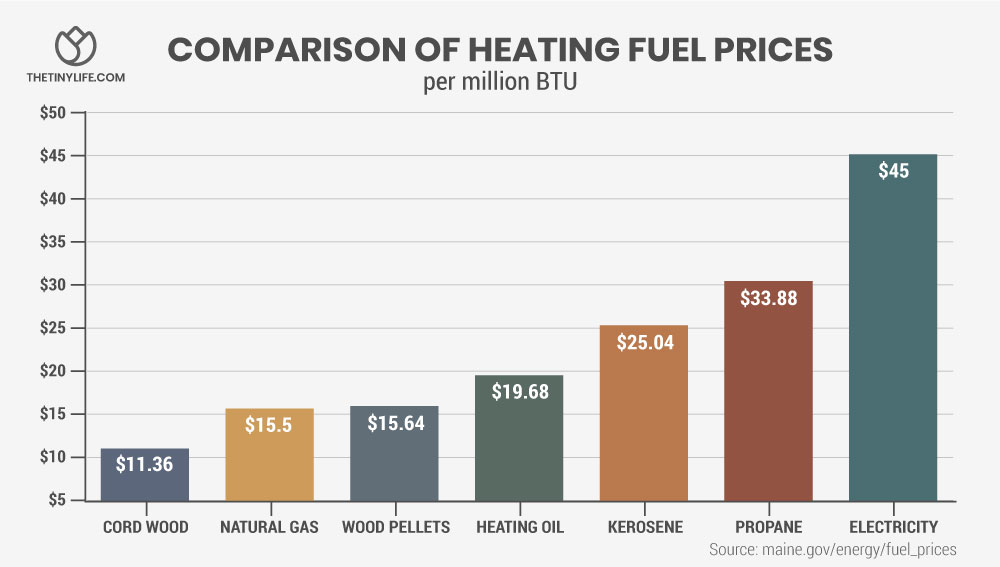
Finally price, money is important. Some setups cost more on the front end and less over time, while some are cheaper to start with and require on going costs or the costs are higher over the long term. I’ll dig into each of these as we go through all the options.
Electric Heater Options For A Tiny House:

Electric Heater Pros
- Inexpensive
- Easy to find at any store
- No installation, just plug in
- Can find the right BTU size for you
Electric Heater Cons
- Takes up floor space
- They’re not particularly good looking
- Expensive to run, draws a lot of power
- Not practical for off the grid
Electric
Cost
- $40-$100
Probably the easiest, cheapest option right now and fairly efficient in terms of heating a space our size. We could get through the rest of the Vermont winter comfortably with our current electric heater but it’s certainly not attractive and it takes up floor space. This option also requires you to be on the grid, most of these heaters start at 1,500 watts for a around 5,000 BTUs and go up from there. With electrical loads like that, you’d have to have a very expensive solar array to power that in the winter.
The great thing about electric heaters is that they’re super cheap, we picked our us for around $45 and you can find that at any major big box retailer. The do work well to heat a space and you have two main options: forced air and radiant heaters.
Forced Air is for when you want to heat up a space fast, the fan in them often is pretty loud, but you can heat the space quickly which is nice when we come home from work and want to turn up the heat. While they are noisy, this is a good option for us because we are out and about often, so we turn down the power while we are gone.
Radiant Heat is for when you can take the time to let a space to heat up. These are often oil filled radiators style heaters, which are near silent in their operation and gently heat the air around them. If you’re on the grid and going to be spending a lot of time in the house this is a good option because you can heat the house up and then let it coast.
Since this would only be a temporary situation right now, seeing as we will be hooking up our solar panels this summer and investing in a small wind generator later in the year. We’re also contemplating micro-hydro electric but that’s for another post!
Heating A Tiny House With A Wood Stove Or Pellet Stove:

Wood or Pellet Stove Pros
- Cozy fire is nice
- Less impact on environment
- Can be used to cook, heat and more
- Fuel generally cheap
Wood or Pellet Stove Cons
- Medium to high initial cost
- Needs large clearances
- Hard to find one small enough
- Takes work and can be messy
Wood or Pellet Stove Cost
- $800-$2,000
We met a tiny house dweller on a farm nearby who uses a wood fired stove. She loves it because she enjoys the processing of the wood and the look of the wood stove in her tiny house. She’s also able to heat water on top for tea making or dish washing. When electricity has gone out during the winter she has had no problems keeping warm and heating food.
There is a homey feeling to a wood stove that you just can’t quite achieve with gas fueled units. However, a wood stove is messier, with ash falling through and wood chips and bark trailing in from the wood.
Tiny House Wood Stove Options
It’s not easy to find a small wood burning fireplace, most are just too big for a small space. Jotul is a popular wood and gas stove company here in Vermont and folks tell us they are the best. We’re not sure they make one small enough for our space so we’re going to check out their showroom this week. We’ve also been looking at Dickinson Marine wood stoves as well as Woodstock soapstone stoves made regionally over in New Hampshire. Kimberly Stoves are also an option, but are expensive.
Finally Hobbit Wood Stoves are a popular options because it’s one of the few best heating options for small homes due to it’s size. It’s designed for small spaces so it’s a serious contender for wood stoves for your tiny house.
There are a few considerations you need to make when it comes to having a wood stove in your tiny house. First is getting a stove small enough for you tiny house, if you don’t size it right, it will generate too many BTUs and leave you roasting inside your tiny house. This happens to most people when they try to heat their small house with wood because it’s hard to find a wood stove that’s small enough.
Next is the space it takes up. Wood stoves require a lot of space just in their size, but also in clearances. You often need to give a good amount of space around the wood stove to make sure it’s safe and doesn’t catch nearby surfaces on fire.
Finally consider your lifestyle and how a wood stove will impact that. Wood stoves require frequent tending, wood needs to be chopped, stacked, then hauled in and finally the stove needs to be cleaned. It’s a lot of hard work and it can be a messy affair when soot gets out. Pellet wood stoves I’ve found to be a happy medium between ease of use, easy temperature maintenance and ease. You can’t really make your own pellets, but there is a strong case to be made for them.
Kerosene Heaters For Indoor Use:

Kerosene Heater Pros
- Vented or un-vented
- Thermostat Controlled
- Burns very clean
Kerosene Heater Cons
- Medium to high initial cost
- Uses fossil fuels
- Hard to find fuel sometimes
Kerosene
Cost
- $80-$1,500
Several people have told us that kerosene is worth the set-up and cost of fuel. It burns really hot and it is 90% efficient according to a local gas supplier. In terms of BTU output kerosene beats out propane, but it’s not as clean burning and is more polluting to the environment although they make filters now that reduce emissions.
Kerosene is the cheaper option when compared to propane, but we have found it’s not as easy to find. I’m also most concerned about carbon monoxide so a vented heater would be essential in such a small space. The Toyotomi Laser kerosene heaters are an option, but I’ve read a lot of mixed reviews. Another option is a free standing kerosene heater like a Dyna-Glo heater, which is nice because you can remove it when not using it. The main downside is that it isn’t a direct vent heater, so you need to be careful about air quality and safety. Overall, kerosene seems like a good option for back-up to electric heating,m but after more online research we are considering this option less and less.
Tiny House Propane Heater Options:

Propane Heater Pros
- Vented or un-vented
- Thermostat Controlled
- Burns very clean
Propane Heater Cons
- Medium-to-high initial cost
- Uses fossil fuels
- Hard to find fuel sometimes
Propane
Cost
- $80-$1,500
Clean burning, efficient, relatively inexpensive and easy to find we’ve seriously considered the propane option. Our stove currently helps heat our house and it’s run off propane so hooking up a heating element wouldn’t be too difficult.
The Dickinson heater is an attractive and efficient option and was a contender to the wood stove option in our deliberations, but after talking with many other tiny housers, we heard a lot of bad things. Mainly that they look nice, but don’t put out enough heat. Even though the Dickinson heater says it puts out 4,000-5,500 BTUs, many people have called that into question. It also lacks a thermostat which was a deal breaker for us.
The other really good option if you’re considering this is a Mr. Heater propane heater. This was great in the south because we didn’t always need a big heater, so we could store it away when we needed to, but on those colder than normal nights we could break it out and heat our tiny house up fast. While it uses 1lb propane canisters, we felt it was very wasteful, so we got the 20lb propane tank connector hose (the size your grill runs off of).
What I like about propane is that it’s pretty cheap, I run my tiny house off of it and we spend about $100 per year heating the house, using it to cook and for my hot water heater for my tiny house. The other thing is you can get the tanks refilled almost anywhere and I prefer to use the 20lb tanks because even when they are full, I can carry them pretty easily.
Tiny House Heat Pumps:

Heat Pump Pros
- Can heat and cool
- Thermostat Controlled
- Takes up no floor space
- Very efficient
Heat Pump Cons
- High initial cost
- Requires some expert help to setup
- Doesn’t work in very cold climates
Heat Pump Cost
- $800-$3,500
This is a good option for people who live on grid, because heat pumps are getting more and more efficient. In really cold locations this should generally be avoided because the system functions by capturing any available heat from the air and concentrating it to heat the home. Once you get to around 30 degrees, most units have electric heating coils to boost the system, but that puts you back in the boat of standard electric heating.
The upside to heat pumps is that the provide heating and cooling for your tiny house, which is what I ultimately decided for my system. While it is difficult, you can run a mini split off solar with a large enough system and an efficient enough system.
The main brands you want to look for is Mitsubishi and Fujitsu, both make good units that are a high SEER rating which is a measure of how efficient they are. You’ll want to find a unity that is at least a SEER 20 for on grid use, if you’re off grid you want to be as high of a SEER rating as possible. At the time of writing this, Carrier just launched a new mini split that is a SEER 42 which is astounding.
What’s great about mini splits is you can mount the air handler on the wall so it doesn’t take up any floor space. It is also programmable, so the thermostat can turn on and off when you want and some even allow you to control via your phone so you can turn it on remotely to come home to a toasty house.
Best Heating Options For A Tiny House:

Now that we’ve broken down some of the major types of heaters for a tiny house, I want to share what I think are the best options when it comes to heating a tiny home.
1. Carrier Infinity Heat Pump – $2,500
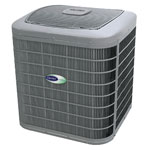 It’s hard to beat these heat pump mini splits because that can heat and cool all in one unit. Their high efficiency inverter heat pump with a SEER of 42 is insane, I have yet to setup one, but I’m guessing it can heat at around 500 watts which is unheard of.
It’s hard to beat these heat pump mini splits because that can heat and cool all in one unit. Their high efficiency inverter heat pump with a SEER of 42 is insane, I have yet to setup one, but I’m guessing it can heat at around 500 watts which is unheard of.
2. Heat Storm Deluxe Indoor Infrared Wall Heater – $80
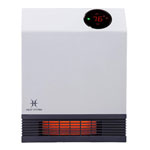 This is the best alternative I’ve found to the popular Envi Flat Panel Heater which is no longer made. What’s great about this heater is it plugs right into an outlet, its very low profile so it doesn’t take up much space because it mounts right on the wall. The kicker is that since it’s just a plug in heater, you can remove it easily and store during the warmer months. At $80 and a 10 minute install it’s hard to beat it if you’re on the grid.
This is the best alternative I’ve found to the popular Envi Flat Panel Heater which is no longer made. What’s great about this heater is it plugs right into an outlet, its very low profile so it doesn’t take up much space because it mounts right on the wall. The kicker is that since it’s just a plug in heater, you can remove it easily and store during the warmer months. At $80 and a 10 minute install it’s hard to beat it if you’re on the grid.
3. The Hobbit Small Wood Stove – $1,100
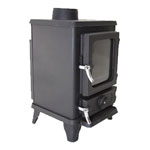 For those who want to go off grid with your heating you’ll need a very small wood stove and the Hobbit Wood Stove is one of the smallest ones out there. While you could go with the Kimberly Stove, its very expensive. At 18 inches x 12 inches you can’t get much smaller and still feed it wood, so this is a great option for those who want to heat and cook with wood.
For those who want to go off grid with your heating you’ll need a very small wood stove and the Hobbit Wood Stove is one of the smallest ones out there. While you could go with the Kimberly Stove, its very expensive. At 18 inches x 12 inches you can’t get much smaller and still feed it wood, so this is a great option for those who want to heat and cook with wood.
4. Mr. Heater – MH9BX Propane Heater – $69
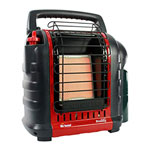 This is a great heater and super practical. It runs off of propane which you get almost anywhere, it’s easily portable and it puts off a lot of heat when you need it. I think everyone should have a Mr. Heater regardless of what heating option you go with as a back up heating source. It can be fuels by 1lb tanks or you can get the hose for grill size tanks.
This is a great heater and super practical. It runs off of propane which you get almost anywhere, it’s easily portable and it puts off a lot of heat when you need it. I think everyone should have a Mr. Heater regardless of what heating option you go with as a back up heating source. It can be fuels by 1lb tanks or you can get the hose for grill size tanks.
5. Oil Filled Radiator Heater – $72
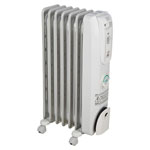 This is another good option and make the cut for my list because they’re good at heating spaces, you can wheel it in when you need heat, but still store it when it’s warmer weather. The oil filled radiator means you have a nice even heat that doesn’t make much noise. The down side to these is that use up a lot of energy, so if you’re off grid it’s not an option and if you are on grid, power bills can be high.
This is another good option and make the cut for my list because they’re good at heating spaces, you can wheel it in when you need heat, but still store it when it’s warmer weather. The oil filled radiator means you have a nice even heat that doesn’t make much noise. The down side to these is that use up a lot of energy, so if you’re off grid it’s not an option and if you are on grid, power bills can be high.
Considerations When Heating Your Tiny House:

The last few points here to consider are safety, indoor air quality, and insulation. Obviously safety is paramount and many of these flame based heaters can lead to fires if you’re not careful. If you have smaller children, a heater on the floor presents a hazard to kids touching it. Indoor air quality is something to consider too. When in such a small space, as you burn fuels you’re using up your oxygen and putting out gasses like carbon monoxide which is serious business. Venting is always preferable, but it’s a trade off because venting takes up a lot of space and need to be done correctly.
Finally if you’re build your own tiny house, it’s important to make sure your house is well sealed and spending more money on insulation upfront will result in a lot less money being spent later on. Don’t skimp on your insulation and choose the highest quality windows that you can afford.
Ultimately our main criteria for heating units include efficiency, safety, cost and environmental impact. We are deliberate in every choice we make with the house and want to make the best choice for our space, the environment and our wallets. It’s not an easy choice but a very necessary one now that we live in a state with actual winter. It’s definitely going to be easier to heat the tiny house than it was to cool it in the hot, humid Southern summers!
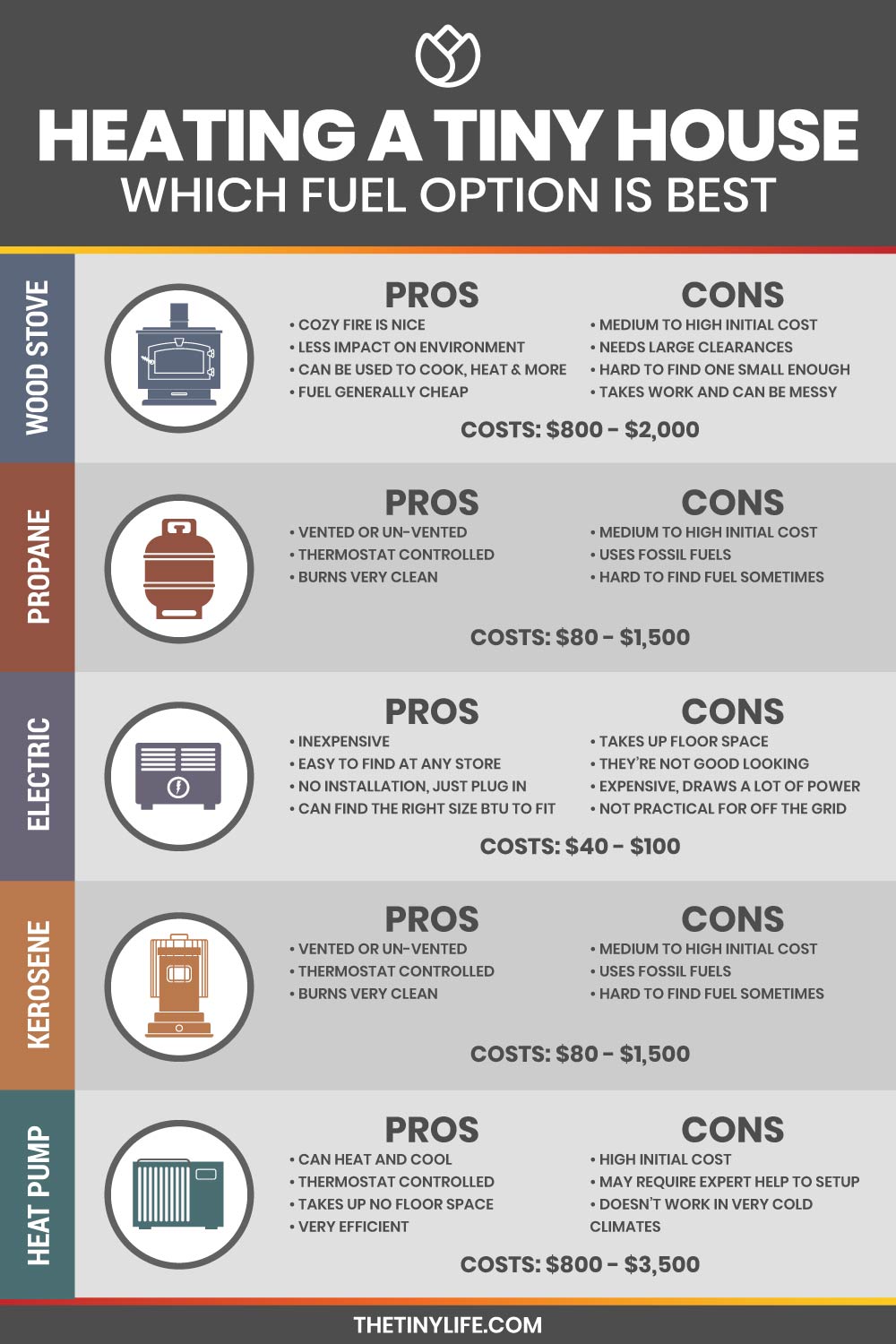
Your Turn!
- What do you recommend for heating a tiny space?
- What options have you considered?
 Choosing A Heater
Choosing A Heater Electric Heaters
Electric Heaters Wood/Pellet Stoves
Wood/Pellet Stoves Kerosene Heaters
Kerosene Heaters Propane Heaters
Propane Heaters Heat Pumps
Heat Pumps My Heater Recommendation
My Heater Recommendation
We wrote a similar post about heating the tiny house back in September 2010 and I don’t think the market has changed all that much. We were faced with the same sort of decisions due to size, cost, fuel, heat generated, etc.
We have ultimately chosen to heat (and cool) with the ClimateRight CR-7000 MAX (https://www.climaterightair.com/cr-7000) which really is a fantastic unit. The ClimateRight is a deluxe, heavy duty, long lasting portable electric AC and heater combo made exclusively for small to medium sized outdoor enclosures and vehicles. Our unit works for 350-1200 cubic feet spaces. We live in 240 sq. ft. so the CR-7000 is ideal!
Installation is super easy as well. In fact, we did a How-To on it that you can see here:
https://www.youtube.com/watch?v=vpX_AXdGXdk
What I like best though is that for what it is, there is no harmful gases or carbon emissions. It runs on standard 115v electric costing about the same as 3-6 lightbulbs.
Drew,
Couple of questions. What did this unit cost you? What ultimately made you decide on this unit rather than a mini-split heat pump? Found your install video, what’s a “Tuba 6” 🙂 Also, smart move building a platform to create more storage.
Tom
The unit originally cost me $750 plus shipping. I decided on the unit because of the low energy pull, the square footage it could handle, and its size/shape. It fit perfectly for my application (sits outside and connects via ductwork to the inside of our tiny house). I didn’t want to take up any wall real estate and to be honest….the units we looked at in that field were too costly at the time. I like the mini-splits and agree they work well but at the time….it just didn’t work for what we needed/wanted.
What’s a tuba 6. That’s funny. Do you know how many folks asked me that? Is my accent that odd? HAHAHAHA.
And thank you for the compliment on the platform. I can’t take credit though. My wife is THE brains of this operation.
You live in 240 sq ft but how high are your ceilings… are you still happy with it? I’m looking at 195 sq feet with a vaulted ceiling and in cubit feet, it seems that this unit would be too small? What has been your experience? Loft stay cool?
We have 12’3″ ceilings. We are still happy with the unit but we have ceiling fans that circulate air and we have 3/4 shade in the hot months so we don’t have that direct sunlight truly impacting us. Oh, and we do not have a loft. We are single level dwellers.
Thanks for info… looks like your unit (7000) is discontinued. Looks like they have a new bigger one coming out but not available yet
Some things to consider before purchasing any stove type heating devices. First, they do get very hot so for safety it shouldn’t be near anything combustible and should be placed on and in front of a non-combustible surface such as stone, brick, masonry, etc. It might be difficult to do this in a tiny space as you probably won’t have the safety clearance around it due to your size constraints. You will also need to have a chimney installed and cleaned every year for safety reasons. I don’t know what your insurance situation is, but many insurance companies will add surcharges for solid fuel burning devices or decide to drop you as a customer if your property is not close enough to a fire hydrant and fire station. Finally, since your home is tiny, you will have to be careful you don’t bump into it and burn yourselves! Good luck with your decisions!
We have heated a 24 x32 story and a half + finished attic with WOOD only for 20 of our 32 years together … recently added a kerosene burning Momitor heater as backup for freedom and age friendly … wodd is very labour intensive. As we consider a drastic downsize to a tiny home, wood will FORVER be part of our heating solutions … simply because of it’s dependability through virtually ANY conditions. As for backup, it will be as green as we can afford and definitely “off grid”
I love the idea of a woodstove in a tiny house, and have seen it done in a few models (Kevin Rose’s Gypsy Rose, Tiny Tack House, Outdoor Research Tiny House).
I think the major pro that outweighs most of the woodstove cons is the reliability of the fuel source. However, I’d also consider a supplementary electric source (radiant underfloor heating, or an electric baseboard) for quick relief of the cold, or if/when leaving a pet at home.
I’d love to hear more from anyone using a woodstove, or contractor opinions about the safety of such!
There are a couple of things at play regarding a wood stove.
Having grown up with wood heat I have had my share of cold middles of the night, waking up and having to run to the stove to stoke the coals, and having to spend afternoon upon afternoon getting firewood. However, the sheer size of a tiny house means less wood and smaller pieces; much easier to procure. I often worry though about the ambient heat being dry (same with propane) in the air, getting quite hot against your wall, and being left unattended in a largely wood home.
The reliability of the fuel source is debatable too contingent on where you live and how friendly your neighbors might be should you run out of wood. I am never a fan of chopping trees down unless there is a replanting effort in place.
Look into a ductless heat pump. Quite suitable for your area, a little expensive but no further costs and they mount high up the wall so they are out of the way and don’t take up valuable space
The Jotul would blow you out of a real tiny house(130-150sqft.
The Sardine made up by me in the Northwest is even a bit overkill unless you burn very small fires.How big(err small)? is your tiny house and have you figured out the heating BTU required to maintain the warmth you desire? Solar panels are not a viable option for conversion to electric heat,nor is storage by battery wind power. Steady microhydro if you have a year round stream that flows enough to generate a few Kw 24/7 would be ideal.
The gas fresh air vented heater used in many tiny homes can be found on the net for well under a grand with some good shopping.
If I turn off my heat and go on a trip and come back to find the temp inside down below freezing it takes me about the equivalent of 1.5 Kw or 5118BTU to raise my tiny house from 28F to a comfy 68F about an hour and then to maintain that temp much less. I built a very small rocket mass heater and it allows high burn temps safely contained and easy to moderate in house temps. .75 pounds of wood fed in over an hour period of time raises temps in winter example above in an hour and then a few chips or twigs of waste wood from a local cabinet shop keeps the mass warm and the house a warm steady temperature.
Vermont winters are colder so a Sardine stove might be the ticket with the wide range of BTU’s from low fuel load wood to crammed full and damper wide open. Pricey though!
Robert
TheTinyBungalow
I would definitely go with the wood stove if you can find one small enough for your house. If you are planning to buy your own land sometime in the future, you should be able to grow all of your own fuel on even a small plot using coppicing and pollarding.
You are never going to be able to produce your own kerosene or propane, on the other hand, and if there is ever a shortage or a severe price spike you could easily find yourself without a heat source. Nor would you be easily able to convert to wood in that situation, as everyone else would be trying to do the same.
One alternative you could use that would give you a bit of a backup plan is a stove that can run on both propane and natural gas. (Note: a conversion kit is required to switch between the two.) You can make natural gas at home using a biogas digester. Whether or not you could make enough to heat your home through a Vermont winter is an open question.
Kimberlyâ„¢ is perhaps the newest kid on the block for heating a tiny house, or other small space. In addition to being able to cook on the top surface, you could simultaneously generate electricity, heat water, and bake, with optional Kimberlyâ„¢ accessories. The Kimberlyâ„¢ stove has a tiny footprint and requires only a 6-inch safety clearance. Weighing just 56 pounds, Kimberlyâ„¢ is also portable. Out of the box Kimberlyâ„¢ burns wood or non-paraffin pressed logs. With modification, Kimberlyâ„¢ will burn other fuels. In fact, Kimberlyâ„¢ burns so efficiently that it was selected as a finalist in the Alliance for Green Heat Wood Stove Decathlon to be held November 2013 in Washington, D.C., sponsored by Popular Mechanics Magazine (among many others). Kimberlyâ„¢ is not inexpensive, but its cost is greatly reduced when you consider the other appliances that Kimberlyâ„¢ could replace when building a tiny house. Kimberlyâ„¢ was born out of necessity when the inventor and his family were forced to live on a boat in Puget Sound, when they lost their business in the down economy. Be sure to site promotion code VLK25 for $25 savings on shipping if you decide to order.
Thank you, Vanessa. This is an absolutely amazing product. I never heard of Kimberly stoves, but now I am sold on them after checking them out! Thank you again and again!!!
My suggestion, radiant floor heating. The heater is generally installed as a sheet between the subfloor and the finish floor, can heat the whole house gently, has no strong heat point to cause fires or burns, and is completely unubtrucive. They come in two flavors: electric or hot fluid.
The electric is the cheaper and easier option of the two. Installation is a snap even for the uninitiated. The down side is the same as all electric heat. You can’t do electric heat with reneable energy (at least not easily or cost effectively), and you’ll need a dedicated, properly sized circuit in your electric panel. The latter is only something to keep in mind during construction, but the former may be a deal breaker.
The hot fluid system is more involved and a poor installation can cause leaks in a place you really can’t get to easily, making repair difficult. The plus side is that heating water is fairly easy by direct renewable sources (evacuated tube solar hot water heaters) which work well even in the far north, but can be backed up or replaced by a propane on demand water heater, which you may already have for your home anyway. Propane models can even be converted to run off of home produced methane if you REALLY want to do it yourself.
On a side note, has anyone seen a one of these floors implimented as an area-rug type installation. That way, you could still access it easily for maintenance or repair.
electric radiant floor heating, while convenient and effective, has a dangerous EMF rating that has an unhealthy, even toxic, effect on humans.
Since winter is more than half over, I’d use the cheapest option for now & replace next fall with whatever it is that you prefer.
What about a gas/electric heater out of a camper? You can have it run off of either electricity or propane and its designed for small places (campers).
There’s also a Dickinson solid fuel heater about the same size as the propane one. https://www.go2marine.com/product/20010F/newport-solid-fuel-heater-00-newsf.html
I like this idea. Wonder how well it works.
To me the tiny house movement is all about efficiency. Efficiency in size, resources and expense. Small hot water tanks are incredibly inefficient considering the amount of time hot water is used for showers and washing dishes, and a space hog in an already tiny house. On demand water heaters solve the efficiency issue and help with the size issue, but are still an expensive option for something used so little.
So,I agree with Grant. Fluid based radiant floor heating but using an on demand propane water heater, with an option to add solar into the system. The key would be to use a variable flame heater which adjusts flame based on incoming water temperature. Essentially you would hook a thermosat to a water pump in a closed loop only heating the water enough to maintain temp until the thermostat was satisfied. You could add a switch at the shower and sinks to return the heater to tap hot water. There is a new sub-flooring product available that is aluminum clad OSB with channels cut in for tubing which makes for a very easy install and incredibly strong. Pipe in a DIY solar water heater and the on demand heater is used only at night.
The increase in costs would be minimal compared to purchasing an additional heater which is only used in the winter. Depending on the climate and whether you had access to grid power the only alternative I think would be efficient and cost effective is a mini-split heat pump providing AC in summer and heat in winter.
Tom
Hello Tom,
Sounds like you have some great insights in the field, maybe our future plans would be of interest to you. We are right now developing a system whereby our wood stove can provide hot water for in floor, hydronic, and domestic hot water. We also are working on thermo electric generators so we can run pumps, fans and keep a battery bank charged. Our stove is now available and was planned for these accessories to be add on components. I am always interested in gaining real world input from people like you who “in the trenches”. This gives us an opportunity to develop products to help you “git er done”. If you would like to discuss any of these ideas I would be interested to know more about these technologies.
Wow! Thanks everyone for the helpful advice. We are checking out the Kimberly wood units. This is all great info!
Dickinson makes a stove that burns wood. It is about the same size as the propane model but is lower in cost.
I’m very happy with my Navigator Little Cod. My house is 120sq ft, I use very little wood. I live in southern Canada with cold winters. Well insulated house, but single pane windows. If it’s really cold I have to get up at night and make an extra fire (-15C or under).
Right now, we’re leaning towards electric radiant floor heat and the Dickinson propane unit. We won’t have the space for wood and with our cold winters we would have to continually add wood throughout the night.
I keep forgetting to fix the typo on our name! 🙂
Make sure you factor in the cost of stove pipe and chimney if you go with a wood stove. We bought a Hobbit (made in England) off of Ebay, and are having a heck of a time finding 4″ pipe and chimney. The marine stove folks have stove pipe, but the chimney is only made in Canada! We haven’t ordered it yet, but it looks like it might double the cost of our stove installation. Still probably worth it (we’ve heated with wood for years now and love the chore), but definitely something to consider before you go out and buy yourself a cute little stove.
Just wanted to put an update here with info that might help anyone considering a Hobbit stove, or marine stove from Shipmate or Navigator. We FINALLY found the 4″ stove pipe and insulated chimney, but FedEx damaged the chimney during shipping. After a long fight with FedEx it looks like they will reimburse us. I put the damaged stuff up on Ebay. You can save yourself upwards of $300 if you don’t mind the dings:
https://www.ebay.com/itm/Selkirk-High-Temp-Model-HT-4-Insulated-Chimney-/151026956435?pt=LH_DefaultDomain_0&hash=item2329e87893
Another bit of advice: I’ve seen a couple people try to install Hobbit stoves with 4″ pellet stove pipe, which is NOT THE SAME THING. 4″ wood stove pipe and insulated chimney is extremely difficult to find and expensive, so I think folks are tempted to use pellet stove pipe. This is NOT SAFE, is a fire hazard, and will cause toxic zinc fumes to burn off in your home.
Something we learned is not all chimney pipe makers are interchangeable in the flue pipe. Buy one brand you must stick with that brand. Not every piece of pipe has the company name brand on the pipe. It is difficult to make double wall pipe join or connect with single or triple wall pipe. Good luck in your search for a chimney flue. Perhaps you can find a craftsman to make the chimney for you.
I can’t image that no one has brought up the negative health effects of burning wood. While wood is a renewable resource, the particulates in wood smoke are very unhealthy.
Please do your research. Here is a starting point: https://www.familiesforcleanair.org/sam-harris-on-the-wood-burning-delusion/
Thanks Bob! That’s a very important aspect to consider-contaminants. Appreciate the link!
HA thats a lobby group crap email with no good facts.
Website fail: CHECK!
I would buy a Kimberly stove and generator in a heartbeat if I could make payments. Who has $4000 laying around! Wish I could afford it. It would be great in my tiny house on wheels.
Has anyone ever heard of or tried the Wallas XC Duo stove? We’re looking into building a Vardo and are wondering whether it will be ok as a heater/stove combo unit.
https://www.wallas.fi/index.php?id=81
I bought 11 acres in globe az off grid that has so much fire wood on it that of myself would never run out of wood i
During the rest if my life. I had hoped to use this resource in my tiny home but it seems that every stove I have checked into still permit some ash to escape out chimney even with an attached spark arrester. With the de casting drought we have been experiencing in the west the tiniest spark will send my available 11acre wood source up in flames in a nanosecond and for one night I and all of my neighbors who are all over 20 acres away from each other into one very hot night which none of would likely recover from and wouldn’t have to worry about ever being warm again depending of course if you go to heaven or the opposite direction. So until I find a very ultra reliable wood burning stove I choose to be neighbor nature friendly and go with propane or natural gas. I know there are problems in the harvesting these fuels but maybe we will live long enough to figure out how to use wood in extreme drought conditions and save our some very ancient forests like the redwoods from our careless use of wood burning equipment can you imagine our nation with out those ancient trees be careful out there everyone stay warm cozy and smart bonnie lee
FYI:
Redwoods need fire to open the sead and to grow populations…
1. Put more spark arresters in the top and bottom of the pipe.
2. electic heat in no way is efficient
3. have water collection off the roof for possible spot fire suppression and clear all Tinder from the house back atleast 30 to 100 yards.
4. the east coast has little fire danger minus times when warnings in the news say such (mainly July if there is a drought which is rare +often than not it rains too much)
Might look into the Rocket Mass heater, above. Even if you’re not concerned about how much wood you burn (since you have a large supply) think about how it is much more efficient, and how no sparks or hot ash EVER leave the unit.
Building such, could mean using only a few sticks a night, in a small structure, and retaining that heat (the “mass” part) for 24 hours or more!
Globe typically doesn’t have long nor harsh winters if I recall,not even as much as Flagstaff (where I lived for 25 years with a woodstove with electric air circulation for a large house.) I think I averaged about 3 to 5 cords of wood with the thing, which was only marginally more efficient than some other designs. (And yes it sometimes put sparks out the chimney, but I was not in a wooded area.)
I use a Cubic Mini Grizzly wood stove to heat ~1050 cu ft. It puts out 12,000 – 18,000 Btu and i also use the top mounted roaster that Cubic sells. The real downside to this stove is it requires reloading every 45-60 minutes and can only take small chunk wood, which is fine if you’re getting logs cut to 7″ long, but a whole lot of work to resize standard cuts. So, staying warm through the night is an issue. To resolve this, I also use a Mr Heater so that I can get some sleep.
https://cubicminiwoodstoves.com/
Big Buddy Heater! I have 20&40lb tanks. I would like a thermostat but I’ve adjusted over 5 Winters. When I had a cat, I put a fireplace screen in front of it. I like the glowing fire. It has to be single digits outside (F) for me to have it on Medium. I have it on Low 99% of the time and I lovingly say I am in Bermuda (temp-wise.) Yes, I open a window by the head of my bed for a little cool, fresh air but I am usually only home to sleep. Cooking alone (or leaving a little flame on my propane stove) takes off a little chill without making it Bermuda but that is a REALLY open flame compared to Mr Heater plus if the flame goes out on the cookstove, the propane does not turn off. Mr Heater turns off automatically if the flame goes out.
Envi wall heaters are still being made, in USA. Low cost, easy to install – either hardwire to thermostat or install as plug-in and purchase accessory plug-in thermostat, exterior housing stays cool for pets/kids, convection style means no fan noise, low watts use. Website: eheat.com.
Good information, thank you!
Being from coastal New England I also used marine resources in my endeavor. I’ve found a company out of Mesick, MI called Fatsco stoves. They make tiny wood stoves ment for heating & cooking in the cabin of long haul fishing boats. Of course it depends on what options are chosen but, a stove with cook top runs around $400.
Best of luck!
Have a look at marinestove.com. They have small wood burning stoves that are perfect. Very expensive but very nice looking too.
We are a military family and so heating and cooling our place is a big concern seeing how we move a lot and will deal with various climates. NY to CA and any states in between are big changes in temperatures. I perplexed for the best route to go.
I have been using a potbelly stove to burn wood in my 480 sq. Foot house that I am currently renovating. I have indoor temps as cold as -5 farenheit in the morning ,wish I could find a supply of anthrocite or butuminous so I could get a long burn
I would love to live in tiny house. I don’t know who would put one up for me. I am 68 yeas old. If I cannot find a small piece of land in Sarasota, FL or someone to get the house made, I don’t know what to do.
I had the same decision with my cape cod house. The natural gas furnace quit working and so what to do. Everyone had opinions, coal, wood, oil, gas, heat pump, etc.
With coal and wood (including pellets), you need a reliable source. There is dirt in the house, gases and smells from combustion, and ashes to remove.
Oil prices fluctuate too much.
With natural gas, kerosene, and propane, you have an explosive in your house. KaBoom!
And heat pumps need good air duct planning, and it always seems they are blowing cold air (in my experience).
My only option remaining was electric baseboard heaters. They have hydronic (fluid filled) units that act like regular heaters but they heat with electricity. There is no boiler, circulating pumps, or pipes that could burst or leak water all over your house.
On the grid, they are great. The local electric company uses a lot of hydro-electric generation but also has other sources, so our rates are low.And electric is a clean and safe way to heat.
What about in-floor heating?
I have read all of the comments written so far by professional and non-professional folks. There is one major factor that NO ONE has mentioned: what about making the structure extremely well built, tight and right; using Metal SIPs, using an Air-to-Air Heat Exchange unit (there are through-the-wall units made for small spaces), a very small HVAC Mini Split system or electric or water radiant heat (can even install it in walls), highly efficient triple pane windows, which all combined will lower the BTU requirements to heat and cool the tiny house AND make it extremely comfortable – no drafts! Electric heat cables or matts can be used with Solar PV and there is finally a new battery storage system available that is supposed to be available in 2021 (2 new factories being built right now), but you might still need A/C depending on your climate. With a highly energy efficient building you could easily use a “window” A/C unit but install it in a wall instead of a window. Build a fire outside next to your patio or deck! No matter the size of the house it must be designed correctly as a system paying acute attention to air quality, water vapor control, water quality/consumption/conservation, energy efficient appliances, lighting design, calculating energy requirements through an ASHRAE Manual J analysis with duct design and terminal design. Ever consider hydroponics? Very doable on a low, tight budget! Many will think that they cannot afford to do all of this BUT how much can you save over the life of ownership by implementing correct and thorough systems design, construction/implementation and operation. You WILL save enough to pay for this in a very short time period (which can be calculated); usually less than 8 to 10 years. Mortgage lenders know this. Does anyone know how to put a dollar value on comfort? Aim for perfection and accept excellence! Best regards to everyone’s future, Rich M.
Important to know within electric heater that you plug directly into the wall and don’t use an extension cord extreme fire hazard.
Somethings you need to consider with a wood stove… Right now, wood in my area is very scarce to buy. In my younger days, I would cut my own, and for free. Now that I am getting older, arthritis prevents me from operating a chain saw. Cleaning the stove pipes, lugging wood and stacking in log piles, and then hauling it up to house are all becoming increasingly hard, and on cold mornings, I now dread having to deal with a fire. If you are lucky, you will be getting older, not younger.
I live too far back in the woods for propane to be delivered, so I am faced with hauling full propane bottles (heavy) to the house, or using expensive electric options. Unless I can find a way to afford solar or wind power. Plan for your future, when deciding about your present.
Hi Sherry, we use 4 100lb propane tanks. And yes moving them is a huge pain! But we found a way around that obstacle. We got an inexpensive small flat trailer, used a pallet, secured it rev well to the trailer and the tanks are secured to that and the rail with tie downs. We asked the propane company make us an length of hose to extend to the trailer. Now we no longer take them off, just the propane guys take them off and on to fill. Yay!! Now we just hook up and drive into town. Easy peasy 😁
Hi, Sherry. I too (Steve L, with posts on this thread in Dec.2021 & Jan. 2022) am getting on in years. From reading your post, it sounds like you may likewise be offgrid, and that despite your living back in the woods, you have a sunny-enuff spot to consider solar power. (Windpower requires a site well above trees and other obstructions, as ‘seemingly’-good, turbulent, inconsistent windgusts are insufficient.) Most folks are under the impression that solarpower is necessarily expensive, not realizing that high quoted costs are mostly middlemen/installer whopping-markups. There are a number of good books about ‘DIY’-installing solar-electric power, and good 12-volt solarpanels are on such as eBay for ~78 cents per watt. I have around $2K in my DIY (now 1,500W) 12-volt solarpanels array, two tandemed $170 solar charge controllers, and two 116 Amp-hour, 12volt sealed AGM batteries. I use a nice little 12 volt, 2.1-cf fridge (which I even coulda postponed, if I’d chosen to get a countertop icemaker & icechest.) My tinyhouse is 8′ × 12′, & I partition-off the half that doesn’t NEED heating/cooling, and during brighter winter-daytimes, turn off the propane, and ‘microzone-heat’ using several 12-volt miniheaters costing <$20 each. (I summer-cool via extensive-wallshading, cool underfloor air, and "thermal-diffs 'radiant' cooling" that can actually leave me shivering on 90+°F days.) -If you'd like to contact me directly with any Q's, Ryan has my permission to give you my email addy. -Best regards!
This post was very helpful! One consideration I would Lille to add is the factor of periods of time you may be absent from the home such as 8 work hours plus 2 commute = your cat/dog/water pipes freeze before you return home, on those exceptionally cold winter days. I realize that does not apply to every climate, but in a conversation about heating, for me it is a factor – consistent heating of the space when not at home for several hours…..
Note that there are now small ductless heat pumps, providing both heat and AC, that run on 120 volt AC, such as this 12,000 BTU model for $800-$1,000.
https://www.homedepot.com/b/Heating-Venting-Cooling-Mini-Split-Air-Conditioners-Mini-Split-Heat-Pumps/110-120v/N-5yc1vZ1z18ggkZ1z1c6qi
Thanks for this. The pros and cons for electricity are contradictory. Explain how they are inexpensive as a pro and expensive as a con. Why not include solar in a set of choices like this? Perhaps just untried by. you so far?
I was wondering why your article doesn’t cover an electric radiant floor heat option. I’ve heard great things about radiant floor heat. Especially because it doesn’t take up any room, it’s light and it’s not a fire hazard.
What is your opinion?
Ryan, Thanks for your articles. No one ever talks about hydronic radiant floor heat. This is what I use in my thow in Michigan. My 16 gallon RV water heater can run on either propane or electric and I use a heat exchanger to heat the fluid in the closed hydronic system. Contact me if you want any details.
Hi, all. I see comments here bemoaning $4K heatstoves and also the admittedly oft-50%-INefficiency of using ‘Grid’-electricity for heat. We tinyhouse-dwellers struggle with finding heatsources that are properly sized for tinyspaces, don’t pollute or affect indoor airquality, and which don’t charge absurd prices for their smallness. You even hear of tinyhousers who must open windows to keep from roasting when using wastefully-oversized or nonadjustable heatsources. Many of us have already invested in thick, high R-value insulation, it sharply reducing the heat required, and in my own case, I afterwards decided against heating separated, ‘closeable’ spaces like closet, pantry, or any of the loft/storage space here in my own 8’×12′, offgrid tinyhouse. Since my actual non-pantry/closet/entryway livingspace is only half of my floorspace, I built an insulated midroom divider-wall with wintertime-installed door, and in winter I lower into place an inches-thick foamboard livingspace dropceiling, to keep 95% of heat from rising higher than 6 feet. Last winter, that limited my 20-lb tanks propane cost to a (total) of $42, and for this winter, I’ve expanded my solarpanels-array (most mounted on summer-sunshading South/West canopies) to a nominal 1,300 watts, (at a present DIY-cost of 78 cents per panel-watt), then installed 650 watts of 12-volt, (mostly 100W-each) miniheaters, each ~2.5″ in diameter, each containing an integral heatblowing minifan, and wired on its own separate switch to allow flexible watts-selectivity. On sunnier days, after nights in the 20’s°F, this is already, in mid-December in East Tennessee, further reducing my daytime heating-propane useage by a daytime 50-90%. ‘Solar’ is ever-cheaper; propane & other fossilfuels, (aside from their climate-impact), are skyrocketing in price, and even the best wood/biomass stoves reportedly affect indoor airquality, as well as heavy wood-fuel being hard for elderly (or those with unforeseen future disabilities) to carry. And excess solar-thermal or solar-electric heat is ‘storable’ as time-release heat in phase-change materials or watertanks located in places such as beneath bed-spaces (a future possibility for which I specified specially-reinforced floors.) Interesting, how we all tinker with heating suited for our particular tinyspaces.. -May we all stay warm, safe and well this winter!
Hello, all. Steve L. again, from central TN, here in my <$4K Mennonite-built, offgrid 8' × 12' tinyhouse on which I then DIY'ed a $2K, 1,300W solarpower system. -Said solarpanels (for now) greatly-hobbled by shadows from 13 passing commercial 'Grid' lines. After sunshading S/W walls with solarpanel canopies and shadelattice, & choosing NOT to directly heat/cool the east half of interior that's merely closet, pantry & entry, I partitioned the west 'actual-livingquarters'-half (8' × 6.25'), installed a thick wintertime foamboard-dropceiling there.. And during reasonably-bright daytimes like today, heat solely with (half) of my 650 total watts of mostly 100W-each, 12-VDC 'microzoned' fanforced-miniheaters; (<$20 each.) Thus far, after nightly temps as low as 10°F.. It's presently 75°F-82°F in this half, using solely solar-electric heat. My tinyhouse itself, for that <$4K cost, is insulated with <$1K of thick sprayfoam, and in winter I wedge thick Reflectix-faced customcut foamblocks into most windows, using two 12V securitycam-monitors for nice outside wintertime views. (So, if one is willing to superinsulate, at least-seasonally 'partition', and not 'superheat' one's closet-contents, pantry, high-ceilingspaces, etc to 72-85°F, but to rather 'microzone' wisely-placed low-voltage, fanforced-miniheaters, to create cocoons of warmth where persons/pets actually habitually ARE, daytime solar-electric heating from a (small) solarpower system and batterybank is provedly possible.. I've greatly curtailed my use of propane, compared to 5 years ago, and this summer plan to get a 500W induction-cooker, new microwave, and a 12-V immersion heater for my pumped showers-reservoir.. -Happy 2022, everyone. Keep warm!
I bought an Amana window unit to heat and cool my East Texas tiny house. When it got below freezing I couldn’t use it because the fan iced up making lots of noise and was worried about the fan breaking. Now a new plan in the work6
Hi, all. I hope that Ryan is having good success with his offered materials, them based on his years of tinyhouse-living experience, in saving those contemplating tinyhouse living (and experienced tinyhouse-dwellers, as well) from making costly and frustrating mistakes in either tinyhouse design, systems, or upgrades. One poll that I saw reported that, like, 54-56% of respondents now say they’d yes, ‘consider’ living in a tinyhouse. The pandemic, and now that heartbreakingly cruel, horribly barbaric war against Ukraine, seem to be causing an acceleration in folks’ interest in how to live more gently & sustainably upon this Earth. For years, we’ve heard how indoor climate-control consumes half a ‘typical’ home’s energy-$ budget. Along with modern R-7/inch insulation mat’ls that superinsulate while minimizing crucial ‘lost space’ in a tinyhouse, rethinking which areas of a tinyhouse really (need) ‘direct/full’ heating and cooling,(yes, here I go again about ‘partitioning’, and ‘cocoons’ of warmth/coolness chiefly aimed directly at/around people and pets!); plus, the new smaller-sized, windowmountable bidirectional (heat AND AC) HEATPUMPS under development, are good news for us tinyhousers, as well. But I’m puzzled by so little seeming awareness & interest shown by the public as yet, (a substantial number of which OWN their land or lot),in harvesting the 54-56°F temps found in North America just a few feet underground (sometimes at less than 10′ depth), and in transferring that ‘summertime-coolness’ & ‘wintertime-preheating’, via air-or fluid-transfer, INTO their above-ground homes.. I do realize that such as thow’s are frequently moved, and that most builders and mortgages-issuers aren’t yet bastions of innovation, but public interest and ‘demand’ DO change things… And for those of us using renewable energy, such as solar-‘PV’ to power our homes, nighttime temps can be mediated to a large degree via new ‘phase change’ interior-walls claddings that store/time-release heat OR coolness after nightfall. As can tanks of WATER, or water-glycol mixtures (such as that that enable me to turn my 12V fridge off at sundown, yet its interior still be <40°F each morning.) Given the $-amounts many tinyhousers are spending anyway, and the fact that 'everything generally COSTS less in a tinyspace' (even tho not necessarily quite directly-'proportionately' so), it'd be nice if a good percentage of us could showcase ways of reducing or eliminating fossilfuels-use for such as our tinyhouses' climate-control systems, if/as soon as personally possible. -Lol, 'IMHO'. -What y'all think, re this? Hope everyone is doing well, in these times. -Steve L.
Here in my little offgrid $4K, Mennonite-built, superinsulated 8’×12′ tinyhouse here in East Tennessee, I continue to make progress in eliminating my use of fossilgas-propane.. My undercounter 3-gallon showers-water reservoir (it likewise filtered, chlorinated rainwater) is already electrically-heated, and 50%+, (most-oft 100%) of my winter HEAT, most days, is from six ~$20-ea. 12V/100W integral blowers-equipped/ separately-switched miniheaters, even HALF of which simultaneously-used thus far, repeatedly soon boosts my livingquarters’ half of this interior well into the 80’s°F.. I just ordered an incredibly-efficent, 120-volt, 3-settings, 500W magnetic-induction cooker, it capable of both quickly boiling and even stir-frying, that has now eliminated my use of propane for pan-cooking (it, as the co. assured me, operates fine on my modified-sinewave inverter power), and in the next few weeks, I’ll be augmenting my (presently passing-Gridlines shadows-hampered) solar-PV array with 3 additional, (ever-cheaper) ‘only in wintertime’ solarpanels, to enable consistently-100% (electrical)-HEATING on not just ‘moderate’ solid-overcast winter days, but on dark-overcast ones, as well.. With moisture-rejecting home-insulations now available in R-7/inch values, they really don’t ‘sacrifice’ all that much tinyhouse-interior space, and will help simplify/minimize heating and cooling needs ever-after, and reduce or even eliminate (subsequent) use of fossilfuels for tinyhouses’ indoor climate-control.. As it hit up to 96°F outdoors locally this last few weeks, my simple solarpowered underfloor-air blower-system, (it presently blowing 67.8°F air), along with my thick insulation and heat-rejecting roof augmented with radiant-barrier, combined with very-effective ‘radiant’ bodyheat-losses to kept-cool indoor surfaces, has continued to keep heat-intolerant, elderly-me comfy and sweat-free WITHOUT traditional-aircon.. (Until, lol, I step-outdoors into a veritable ‘oven’!) -Far easier, methinks, (especially in tinyhouses), to shell-out the necessary-$ to help, whenever possible, to PREVENT penetration of undesireable outdoor temps, than to ever-after have to use energy-gulping (and needlessly-oversized, space-hogging) heating and cooling equipment.. My efficient 12V underfloor-cooling blower is UNDER my closeable, screened floorgrate, and my six 12V, 100W-each winter-miniheaters are only a mere ~2.7″ in diameter, most mounted very-unobtrusively underneath shelves, aimed ‘right-at’ persons/pets, to heat them FIRST.. -Sure works for me! -Steve L. in Tennessee
Hi again. When I posted on Sept 10th, I mentioned that I intend, in October, to increase my offgrid 8’×12′ tinyhouse’s solarpanels-array from 1,500 to 1,800 nominal watts, to enable me to heat and cook SOLELY, 100%, solar-electrically ‘even’ on (darkest)-overcast winter days.. I already ‘store’ (coldness) overnight in my turned-off-nightly 12V solarfridge, via added fridge-insulation and topmost-shelf Blue Ice packs, (enabling my just $400 of AGM housebatteries to continue to suffice), and my several 12V, 100W miniheaters ALONE to keep me toasty-warm, most winter-DAYtimes; but, seeing at LEAST a coupla-hundred daytime solarwatts oft merely going to waste, I’m constructing an under-bunk, excess daytime-solarwatts-using, heat-STORAGE system to provide (night)time heat within my drawcurtained-bunkcubby.. It consisting of: an insulated underbunk bin of scrap aluminum and jugged water, that mass daytime-heated by a couple of the same-model 12V miniheaters that I use elsewhere for blown-air (day)time heat, that heat then nightly ‘closed-looped’ blown thru my bunkcubby by low-voltage thermostat-controlled 4″ muffinfan-blowers mounted within common 4″-diam dryer-flexduct run the needed inches-upwards, from the heat-bin.. (I already HAD half the needed materials at hand.) -So, before first snowfall, not only my (fridge), but also my ‘nightly bunkcubby-heat’, as well, will NOT draw any nighttime batteries-current at all, save for 6 total watts of duct-miniblowers.. -Along with my new 500W induction cooker that amazingly performs like one of twice the wattage,and barely even affects the batts-voltage when I briefly cook after sundown), ‘this’ winter, I aim to continue my present DIS-use of fossilgas-propane entirely. (Last winter, I’d burned a TOTAL of $42-worth of propane, that having itself been half the previous year’s total.) -If we tinyhousers R-7/inch SUPERinsulate (involving a coupla ‘lost’ wallspace inches, ‘compared’ to the alternative of bulky heatsystems also requiring FEET of firesafety-‘clearances’, (my 100W-each miniheaters, mounted unobtrusively underneath the lip of shelves and counters, are a mere 2.7″ in diameter, and, during single-digit outdoor winter temps, provedly can soon boost livingquarters-half temps past the mid-80’s°F) -plus also figure-out ways to daytime-‘store’ heat for nighttime use.. Then maybe we can AVOID expensive, precious-space hogging, dirty-fossilfuels heaters, or soot/smoke/ashes-producing ones that have us up hourly nightly, tending them.. And, while I can’t pretend to know others’ personal circumstances or their crucial constraints, I’m a bit surprised that I’m accomplishing the ‘tweaks/improvements’ that I am, using now merely a tiny, 3-figures monthly Social Security retirement check as sole income.. Lol; back to work now, preparing for winter, like a grayheaded squirrel storing up nuts! -Steve L.
Question for Ryan and anyone else who’s experienced this conundrum : based on your recommendation in this article, along with the manufacturer’s website stating the heater was “safe for indoor use, ” I purchased a Mr. Heater propane space heater, MH9BX the same model you discussed. So I open the box and begin perusing the owners manual and on the first page in bold letters is the warning that this heater is “for OUTDOOR use only!” What gives? I mean, I know that the propane tank itself must be kept outside– which is why I also purchased a Mr. Heater-approved extension hose /adapter to use a 20 lb grill tank with the heater. Propane tank outside, adaptor/hose running in though cracked window to connect to heater inside. But the manual says the heater ITSELF must be used outdoors. Seriously? Who wants to heat the outdoors?! So is this thing safe to use indoors or not? I want it as a back up heat source for when power is out and I cannot use my electric heater. Please advise! And thank you for a great blog.
Hi, all.
Here’s a little update, following my last post in September, 2022.
I’ve now expanded my solarpowered offgrid 8′ by 12′ tinyhouse’s solar-PV array to 2,000 nominal watts, and my yearly expenditure on propane has now dropped to $0, that also enabled by a new induction-cooker.
My seven little (2.5″-diameter) 12-volt, mostly 100-watt each, minifans-equipped miniheaters easily heat the subdivided actual livingquarters-half of my total 96 square feet into the 80’sF. during single-digits weather, and in winter, I now (nightly) heat my built-in, further-insulated, drawcurtained (bunkcubby) with (daytime-STORED) solar-electric heat, stored in an insulated water-bin beneath my bunk, that stored heat nightly ducts-looped/ thermostatically-blown thru my bunkcubby by two 3-watt ductfans…
My tinyhouse continues to be kept a comfy, sweat-free temp, during up to 94-degree F. outdoor summertime temps, by a simple underfloor-air powered floorgrate equipped with an 800-cfm intake-blower that blows in cool underfloor air that’s replenished solely from my tinyhouse’s shady North side, and eventually exits two high gablevents.
A shiny, heat-rejecting Galvalume roof, thick R-7/in. insulation, foamcore ceiling radiant-barrier, and projecting, (100% walls-sunshading) South & Westsides solarpanels-canopies and shade-latticework, further keep the interior cool.
Since summers grow ever-hotter, I’ve considered eventually installing a ‘small’ (5,000-BTU) 120-V AC window-AC to run via my little-needed inverter, but that would (brrr!) freeze me, within a subdivided mere 8′ by 6.25′) space… -And roughly-2,000-BTU, low-voltage ‘camping/tent’ AC’s are still very expensive.
-So I’m considering using most of a rated daily (26 pounds of) countertop icemaker’s mini-cubes, to summertime load-into that same underbunk ‘thermal storage’ bin, to in peak-summer then thermostatically-circulate stored coolness 24/7, insteada heat… (I continue to switch-OFF my 12-volt fridge/freezer nightly, its glycol-stored, near-0’F. ‘superchill’ easily maintaining the fridge-portion contents at below 40F, overnight.)
On some (yet-future) tinyhouse lot/location, installing a summertime-aircooling, wintertime air-preheating ‘earthtube’ may also be a possibility..
-My best to all, ‘Steve L’, here in East Tennessee
:3
I am interested in a barn style roof dwelling about 16 x 20 do you have plan like this